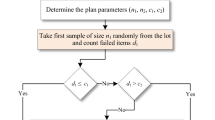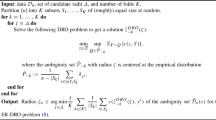Abstract
The uncertainties of input variables are quantified as probabilistic distribution functions using parametric or nonparametric statistical modeling methods for reliability analysis or reliability-based design optimization. However, parametric statistical modeling methods such as the goodness-of-fit test and the model selection method are inaccurate when the number of data is very small or the input variables do not have parametric distributions. To deal with this problem, kernel density estimation with bounded data (KDE-bd) and KDE with estimated bounded data (KDE-ebd), which randomly generates bounded data within given input variable intervals for given data and applies them to generate density functions, are proposed in this study. Since the KDE-bd and KDE-ebd use input variable intervals, they attain better convergence to the population distribution than the original KDE does, especially for a small number of given data. The KDE-bd can even deal with a problem that has one data with input variable bounds. To verify the proposed method, statistical simulation tests were carried out for various numbers of data using multiple distribution types and then the KDE-bd and KDE-ebd were compared with the KDE. The results showed the KDE-bd and KDE-ebd to be more accurate than the original KDE, especially when the number of data is less than 10. It is also more robust than the original KDE regardless of the quality of given data, and is therefore more useful even if there is insufficient data for input variables.














Similar content being viewed by others
References
Agarwal H, Renaud JE, Preston EL, Padmanabhan D (2004) Uncertainty quantification using evidence theory in multidisciplinary design optimization. Reliab Eng Syst Saf 85(1):281–294
Akaike H (1974) A new look at the statistical model identification. IEEE Trans Autom Control 19(6):716–723
Analytical Methods Committee (1989) Robust statistics-how not to reject outliers. Part 1. Basic concepts. Analyst 114(12):1693–1697
Anderson TW, Darling DA (1952) Asymptotic theory of certain goodness of fit criteria based on stochastic processes. Ann Math Stat 23(2):193–212
Ayyub BM, McCuen RH (2012) Probability, statistics, and reliability for engineers and scientists. CRC Press, Florida
Betrie GD, Sadiq R, Morin KA, Tesfamariam S (2014) Uncertainty quantification and integration of machine learning techniques for predicting acid rock drainage chemistry: a probability bounds approach. Sci Total Environ 490:182–190
Betrie GD, Sadiq R, Nichol C, Morin KA, Tesfamariam S (2016) Environmental risk assessment of acid rock drainage under uncertainty: the probability bounds and PHREEQC approach. J Hazard Mater 301:187–196
Burnham KP, Anderson DR (2004) Multimodel inference: understanding AIC and BIC in model selection. Sociol Methods Res 33(2):261–304
Chen S (2015) Optimal bandwidth selection for kernel density functionals estimation. J Probab Stat 2015:21
Cho SG, Jang J, Kim S, Park S, Lee TH, Lee M, Choi JS, Kim HW, Hong S (2016) Nonparametric approach for uncertainty-based multidisciplinary design optimization considering limited data. Struct Multidiscip Optim 54(6):1671–1688
Cowling A, Hall P (1996) On pseudodata methods for removing boundary effect in kernel density estimation. J R Stat Soc Ser B Methodol 58(3):551–563
Cox M, Harris P (2003) Up a GUM tree? Try the full monte! National Physical Laboratory, Teddington
Eldred MS, Agarwal H, Perez VM, Wojtkiewicz SF Jr, Renaud JE (2007) Investigation of reliability method formulations in DAKOTA/UQ. Struct Infrastruct Eng 3(3):199–213
Frigge M, Hoaglin DC, Lglewicz B (1989) Some implementations of the boxplot. Am Stat 43(1):50–54
Gabauer W (2000) Manual of codes of practice for the determination of uncertainties in mechanical tests on metallic materials, the determination of uncertainties in tensile testing. UNCERT COP7 report, Project SMT4-CT97-2165
Gasser T, Müller HG (1979) Kernel estimation of regression functions. Smoothing Techniques for Curve Estimation 757:23–68
Guidoum AC (2015) Kernel estimator and bandwidth selection for density and its derivatives. Department of Probabilities & Statistics, Faculty of Mathematics, University of Science and Technology Houari Boumediene, Algeria, https://cran.r-project.org/web/packages/kedd/vignettes/kedd.pdf
Hansen BE (2009) Lecture notes on nonparametrics. University of Wisconsin-Madison, WI, USA, http://www.ssc.wisc.edu/~bhansen/718/NonParametrics1.pdf
Hardle W, Marron JS, Wand MP (1990) Bandwidth choice for density derivatives. J R Stat Soc Ser B Methodol 52(1):223–232
Jang J, Cho SG, Lee SJ, Kim KS, Hong JP, Lee TH (2015) Reliability-based robust design optimization with kernel density estimation for electric power steering motor considering manufacturing uncertainties. IEEE Trans Magn 51(3):1–4
Jones MC, Kappenman RF (1992) On a class of kernel density estimate bandwidth selectors. Scand J Stat 19(4):337–349
Jung JH, Kang YJ, Lim OK, Noh Y (2017) A new method to determine the number of experimental data using statistical modeling methods. J Mech Sci Technol 31(6):2901–2910
Kang YJ, Lim OK, Noh Y (2016) Sequential statistical modeling for distribution type identification. Struct Multidiscip Optim 54(6):1587–1607
Kang YJ, Hong JM, Lim OK, Noh Y (2017) Reliability analysis using parametric and nonparametric input modeling methods. J Comput Struct Eng Inst Korea 30(1):87–94
Karanki DR, Kushwaha HS, Verma AK, Ajit S (2009) Uncertainty analysis based on probability bounds (P-box) approach in probabilistic safety assessment. Risk Anal 29(5):662–675
Karunamuni RJ, Alberts T (2005a) On boundary correction in kernel density estimation. Stat Methodol 2(3):191–212
Karunamuni RJ, Alberts T (2005b) A generalized reflection method of boundary correction in kernel density estimation. Can J Stat 33(4):497–509
Karunamuni RJ, Zhang S (2008) Some improvements on a boundary corrected kernel density estimator. Stat Probab Lett 78(5):499–507
Marron JS, Ruppert D (1994) Transformations to reduce boundary bias in kernel density estimation. J R Stat Soc Ser B Methodol 56(4):653–671
Montgomery DC, Runger GC (2003) Applied statistics and probability for engineers (3rd edition). Wiley, New York
Noh Y, Choi KK, Lee I (2010) Identification of marginal and joint CDFs using Bayesian method for RBDO. Struct Multidiscip Optim 40(1):35–51
Schindler A (2011) Bandwidth selection in nonparametric kernel estimation. PhD Thesis. Göttingen, Georg-August Universität, Diss
Schuster EF (1985) Incorporating support constraints into nonparametric estimators of densities. Commun StatTheory Methods 14(5):1123–1136
Schwarz (1978) Estimating the dimension of a model. Ann Stat 6(2):461–464
Scott DW, Terrell GR (1987) Biased and unbiased cross-validation in density estimation. J Am Stat Assoc 82(400):1131–1146
Shah H, Hosder S, Winter T (2015) Quantification of margins and mixed uncertainties using evidence theory and stochastic expansions. Reliab Eng Syst Saf 138:59–72
Sheather SJ (2004) Density estimation. Stat Sci 19(4):588–597
Sheather SJ, Jones MC (1991) A reliable data-based bandwidth selection method for kernel density estimation. J R Stat Soc Ser B Methodol 53(3):683–690
Silverman BW (1986) Density estimation for statistics and data analysis, vol 26. CRC press, London
Tucker WT, Ferson S (2003) Probability bounds analysis in environmental risk assessment. Applied Biomathematics, Setauket, New York, http://www.ramas.com/pbawhite.pdf
Tukey JW (1977) Exploratory data analysis. Pearson, New York
Verma AK, Srividya A, Karanki DR (2010) Reliability and safety engineering. Springer, London
Wand MP, Jones MC (1994) Kernel smoothing. CRC press, London
Yao W, Chen X, Quyang Q, Van Tooren M (2013) A reliability-based multidisciplinary design optimization procedure based on combined probability and evidence theory. Struct Multidiscip Optim 48(2):339–354
Youn BD, Jung BC, Xi Z, Kim SB, Lee WR (2011) A hierarchical framework for statistical model calibration in engineering product development. Comput Methods Appl Mech Eng 200(13):1421–1431
Zhang Z, Jiang C, Han X, Hu D, Yu S (2014) A response surface approach for structural reliability analysis using evidence theory. Adv Eng Softw 69:37–45
Acknowledgments
This work was supported by the National Research Foundation of Korea (NRF) grant, funded by the Korean Government (NRF-2015R1A1A3A04001351) and by the Technology Innovation Program (10048305, Launching Plug-in Digital Analysis Framework for Modular System Design) and the Human Resources Development program (No. 20164030201230) of the Korea Institute of Energy Technology Evaluation and Planning (KETEP) grant funded by the Ministry of Trade, Industry and Energy. This support is greatly appreciated.
Author information
Authors and Affiliations
Corresponding author
Appendix 1: Silverman’s rule of thumb
Appendix 1: Silverman’s rule of thumb
The Silverman’s rule of thumb is a method which minimizes an objective function, mean integrated squared error (MISE), and it is probably the most popular one among the bandwidth selection methods (Schindler 2011). It assumes that true density is normally distributed therefore Silverman’s rule will compute a bandwidth close to optimal if a random variable X is reasonably close to the normal distribution (Silverman 1986; Hansen 2009). It defines according to various kernel functions as follows (Hansen 2009).
where C ν (k) is the constant from Table 12, and ν is the order of the kernel.
Rights and permissions
About this article
Cite this article
Kang, YJ., Noh, Y. & Lim, OK. Kernel density estimation with bounded data. Struct Multidisc Optim 57, 95–113 (2018). https://doi.org/10.1007/s00158-017-1873-3
Received:
Revised:
Accepted:
Published:
Issue Date:
DOI: https://doi.org/10.1007/s00158-017-1873-3




